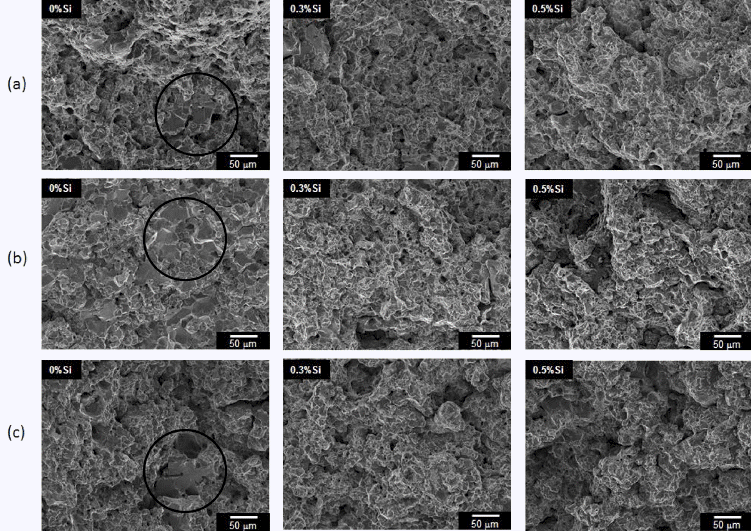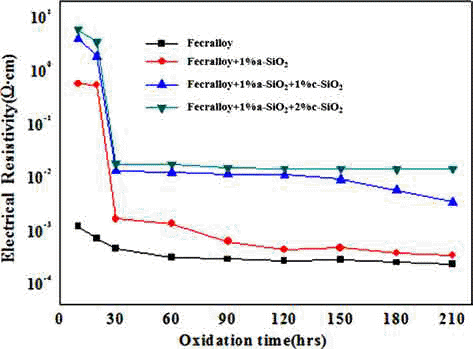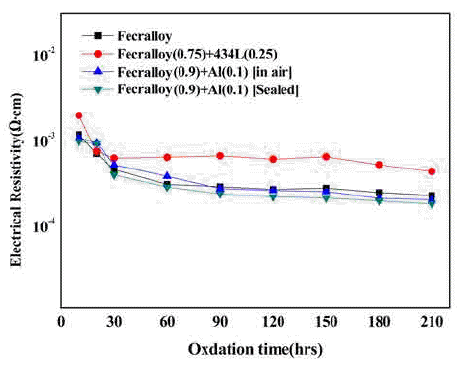Search
- Page Path
- HOME > Search
- [Korean]
- The Effects of Si or Sn on the Sintered Properties of Fe-(Mo,Mn)-P Lean alloy
- Woo-Young Jung, Jin-Uk Ok, Dong-Kyu Park, In-Shup Ahn
- J Korean Powder Metall Inst. 2018;25(4):302-308. Published online August 1, 2018
- DOI: https://doi.org/10.4150/KPMI.2018.25.4.302

- 386 View
- 1 Download
-
 Abstract
Abstract
 PDF
PDF A lean alloy is defined as a low alloy steel that minimizes the content of the alloying elements, while maintaining the characteristics of the sintered alloy. The purpose of this study is to determine the change in microstructure and mechanical properties due to the addition of silicon or tin in Fe-Mo-P, Fe-Mn-P, and Fe-Mo-Mn-P alloys. Silicon- or tin-added F-Mo-P, Fe-Mn-P, and Fe-Mo-Mn-P master alloys were compacted at 700 MPa and subsequently sintered under a H2-N2 atmosphere at 1120°C. The sintered density of three alloy systems decreases under the same compacting pressure due to dimensional expansion with increasing Si content. As the diffusion rate in the Fe-P-Mo system is higher than that in the Fe-P-Mn system, the decrease in the sintered density is the largest in the Fe-PMn system. The sintered density of Sn added alloys does not change with the increasing Sn content due to the effect of non-dimensional changes. However, the effect of Si addition on the transverse rupture strengthening enhancement is stronger than that of Sn addition in these lean alloys.
- [Korean]
- Sintering behavior of Fe-(Mo-Mn-P)-xSi alloys according to the Green Density
- Woo-Young Jung, Jin-Uk Ok, Dong-Kyu Park, In-Shup Ahn
- J Korean Powder Metall Inst. 2017;24(5):400-405. Published online October 1, 2017
- DOI: https://doi.org/10.4150/KPMI.2017.24.5.400

- 815 View
- 3 Download
- 1 Citations
-
 Abstract
Abstract
 PDF
PDF The addition of a large amount of alloying elements reduces the compactibility and increases the compacting pressure, thereby shortening the life of the compacting die and increasing the process cost of commercial PM steel. In this study, the characteristic changes of Fe-Mo-P, Fe-Mn-P, and Fe-Mo-Mn-P alloys are investigated according to the Si contents to replace the expensive elements, such as Ni. All compacts with different Si contents are fabricated with the same green densities of 7.0 and 7.2 g/cm3. The transverse rupture strength (TRS) and sintered density are measured using the specimens obtained through the sintering process. The sintered density tends to decrease, whereas the TRS increases as the Si content increases. The TRS of the sintered specimen compacted with 7.2 g/cm3 is twice as high as that compacted with 7.0 g/cm3.
-
Citations
Citations to this article as recorded by- The Effects of Si or Sn on the Sintered Properties of Fe-(Mo,Mn)-P Lean alloy
Woo-Young Jung, Jin-Uk Ok, Dong-Kyu Park, In-Shup Ahn
Journal of Korean Powder Metallurgy Institute.2018; 25(4): 302. CrossRef
- The Effects of Si or Sn on the Sintered Properties of Fe-(Mo,Mn)-P Lean alloy
- [Korean]
- The Effect of SiO2 addition on Oxidation and Electrical Resistance Stability at High-temperature of P/M Fecralloy Compact
- Jin-Woo Park, Jin-Uk Ok, Woo-young Jung, Dong-kyu Park, In-Shup Ahn
- J Korean Powder Metall Inst. 2017;24(4):292-297. Published online August 1, 2017
- DOI: https://doi.org/10.4150/KPMI.2017.24.4.292

- 383 View
- 1 Download
-
 Abstract
Abstract
 PDF
PDF A metallic oxide layer of a heat-resistant element contributes to the high-temperature oxidation resistance by delaying the oxidation and has a positive effect on the increase in electrical resistivity. In this study, green compacts of Fecralloy powder mixed with amorphous and crystalline silica are oxidized at 950°C for up to 210 h in order to evaluate the effect of metal oxide on the oxidation and electrical resistivity. The weight change ratio increases as per a parabolic law, and the increase is larger than that observed for Fecralloy owing to the formation of Fe-Si, Fe-Cr composite oxide, and Al2O3 upon the addition of Si oxide. Si oxides promote the formation of Al2O3 and Cr oxide at the grain boundary, and obstruct neck formation and the growth of Fecralloy particles to ensure stable electrical resistivity.
- [Korean]
- A Study on the Development of Compactability and Electrical Resistivity for P/M Fecralloy
- Jin-Woo Parka, Byung-Hyun Ko, Woo-Young Jung, Dong-Kyu Park, In-Shup Ahn
- J Korean Powder Metall Inst. 2016;23(6):426-431. Published online December 1, 2016
- DOI: https://doi.org/10.4150/KPMI.2016.23.6.426

- 383 View
- 1 Download
-
 Abstract
Abstract
 PDF
PDF The Fe-Cr-Al alloy system shows an excellent heat resistance because of the formation of an Al2O3 film on the metal surface in an oxidizing atmosphere at high temperatures up to 1400°C. The Fecralloy needs an additive that can act as a binder because of its bad compactability. In this study, the green compacts of STS434L and Al powder added to Fecralloy are oxidized at 950°C for up to 210 h. Fecralloy and Al is mixed by two types of ball milling. One is vented to air and the other was performed in a sealed jar. In the case of Al addition, there are no significant changes in the electrical resistance. Before the oxidation test, Al oxides are present in the Fecralloy surface, as determined from the energy dispersive spectroscopy results. The addition of Al improves the compactability because of an increased density, and the addition of STS434L increases the electrical resistivity by forming a composite oxide.
- [Korean]
- Mechanical Properties of Fe-P-(Mo,Mn) Sintered Alloy Related with Si Contents
- Woo-Young Jung, Dong-Kyu Park, Byung-Hyun Ko, Jin-Woo Park, In-Shup Ahn
- J Korean Powder Metall Inst. 2016;23(5):397-401. Published online October 1, 2016
- DOI: https://doi.org/10.4150/KPMI.2016.23.5.397

- 525 View
- 3 Download
- 2 Citations
-
 Abstract
Abstract
 PDF
PDF A lean alloy is defined as a low alloy steel with a minimum amount of the alloying element that maintains the characteristics of the sintered alloy. It is well known that the addition of elements such as Cr, P, Si, or Mn improves the mechanical characteristics of the alloy, but decreases the sinterability. The mother alloy is used to avoid an oxidation reaction with the alloying elements of Cr, P, Si or Mn. The purpose of this study is to determine the change in the mechanical properties of Fe-P-Mo and Fe-P-Mn alloys as a result of the addition of Si. In this article, the Fe-P-Mo and Fe-P-Mn alloys to which Si is added are compacted at 7.0 g/cm3 and then sintered in H2-N2 at 1120°C. The P around the macropores and large grains reduces due to the formation of SiO2 as the Si content increases. This is caused by the increase in strength owing to reducing intergranular fracture by suppressing the reaction with oxygen.
-
Citations
Citations to this article as recorded by- The Effects of Si or Sn on the Sintered Properties of Fe-(Mo,Mn)-P Lean alloy
Woo-Young Jung, Jin-Uk Ok, Dong-Kyu Park, In-Shup Ahn
Journal of Korean Powder Metallurgy Institute.2018; 25(4): 302. CrossRef - Sintering behavior of Fe-(Mo-Mn-P)-xSi alloys according to the Green Density
Woo-Young Jung, Jin-Uk Ok, Dong-Kyu Park, In-Shup Ahn
Journal of Korean Powder Metallurgy Institute.2017; 24(5): 400. CrossRef
- The Effects of Si or Sn on the Sintered Properties of Fe-(Mo,Mn)-P Lean alloy
- [Korean]
- The Effect of Oxide Compound on Electrical Resistivity and Oxidation Stability in High-temperature for Ferritic P/M Stainless Steel
- Jin-Woo Park, Byung-Hyun Ko, Woo-young Jung, Dong-Kyu Park, In-Shup Ahn
- J Korean Powder Metall Inst. 2016;23(3):240-246. Published online June 1, 2016
- DOI: https://doi.org/10.4150/KPMI.2016.23.3.240

- 424 View
- 1 Download
-
 Abstract
Abstract
 PDF
PDF In order to improve the high-temperature oxidation stability, sintered 434L stainless steel is studied, focusing on the effect of the addition of metallic oxides to form stable oxide films on the inner particle surface. The green compacts of Fecralloy powder or amorphous silica are added on STS434L and oxidized at 950°C up to 210 h. The weight change ratio of 434L with amorphous silica is higher than that of 434L mixed with Fecralloy, and the weight increase follows a parabolic law, which implies that the oxide film grows according to oxide diffusion through the densely formed oxide film. In the case of 434L mixed with Fecralloy, the elements in the matrix diffuse through the grain boundaries and form Al2O3 and Fe-Cr oxides. Stable high temperature corrosion resistance and electrical resistivity are obtained for STS434L mixed with Fecralloy.
TOP
 kpmi
kpmi


 First
First Prev
Prev


